In the Holy Warriors succession game, we kind of touched on how to spread religion widely, but didn't really get all that far with it. I promised the Holy Warriors team 50 faith/turn from the Pilgrimage belief, which never happened (we got up to about 20), but I still have to deliver on that somehow.
I want to play a game dedicated to spreading religion as massively as possible, using the Pilgrimage belief that we never really maxed out in the succession game. I'm aware there's not much point to doing this on its own, all you do is spend faith to get more faith to spend on more faith. But there are a few areas of payoff I can identify.
One is founder beliefs. Founder beliefs are the way you get rewarded for spreading your religion wide. But you only get one founder belief, which Pilgrimage itself consumes. Unless... you're Byzantium! That's the plan, use Byzantium to stack up a second founder belief along with Pilgrimage while going wide with religion.
The second goal is getting the World Congress to adopt my world religion, which naturally feeds into a tourism victory. Along with that comes the plan of using the big faith production to take advantage of the three separate Great Writer/Artist/Musician cost scales for purchasing with faith.
And I'll continue the principle I've been doing of deep dives into policy trees, obviously Piety here. So I assembled a plan of stacking up everything to feed into missionaries. The Great Mosque is a must. Holy Order (-30% missionary cost) will be the enhancer belief, stacked with the Mandate of Heaven policy (-20%). And the Reformation policy will be Evangelism. The effect is "missionaries erode 25% of existing pressure" which is hard to gauge given the opacity of the spreading mechanic in the first place. But this post and a few other threads on CFC say that the belief is surprisingly powerful, so I'll try this out myself.
- Summarizing:
- Piety first
- Stack up the religious wonders: Great Mosque, Borobudur, Hagia Sophia
- Stack up the missionry enhancers: Great Mosque, Mandate of Heaven, Holy Order, Evangelism
- Second founder belief will be Ceremonial Burial, which was nerfed in BNW but let's see by how much
- World Religion by the congress, which means tourism victory
- Full dedication of faith into missionaries, not prophets or faith buildings
- Use surplus faith late for GWAMs
And of course this does call for a cooked map setup favoring religion, as I did so many times in G&K. So far in my BNW games I've stayed away from that, but this is what I was saving it for. Time to go back to the old favorite of Inland Sea, Hot, to get swaths of desert for Desert Folklore.
This report is my second attempt at the setup. In the first, I diverted to Currency for Petra before going towards Theology, but that was a mistake as it delayed the religious stuff for too long. Better to keep a focused game plan.

Ruins: Animal Husbandry. And wow exactly on the turn I finished Pottery research, WRITING! Population ruin to size 4. Got a culture ruin late-ish on turn 18 but good enough, and another on turn 23. Faith on turn 22 for the pantheon. 60 gold and 80 gold into a bought worker on turn 28, decent enough. And finally Bronze Working from a ruin - super key because I was going to let that tech slide for a while, but there was iron right at Constantinople.
Build order: scout - scout - scout - shrine - monument - Great Library - granary - National College while still at 1 city. That's how to get to Theology for the religious wonders as fast as possible, use the GL for Philosophy into the fast NC. Leaving aside Petra on this glorious desert start had to hurt, but that's not the plan this game, we will do that some other time.

Here's an overview of the surroundings, and also notice the worker steal about to happen down south at Prague there. That was my second worker after buying the first with hut gold. I sold citrus on turn 33 for 6 gpt, almost full value.
India was my neighbor to the west past Mogadishu, and he surprised me by friending me very early, turn 38! This happens so randomly in BNW. I wish I knew why. It's not a normal progression of diplomatic modifiers, these random friendships come so early before any of that can happen. It just seems totally random. But getting those random friendships makes a huge difference, letting you sell stuff for gold early, and they will usually stay friends all game for more sales and later research agreements. My Sweden game only got one friendship and I felt it was always lagging behind where it should be on sales.
Anyway, I sold India my 5 iron for full cash value on turn 40 and bought my third worker for a great boost up the growth curve. That was followed by more sales of citrus on T47 and silver T49. Portugal also gave me one of those early baseless friendship declarations.

There's the Great Library slingshot. And also a look at the barbarians. Although I've never seen it mentioned in any change logs or anything, the barbarian spawn rate has to have been jacked up in BNW. Every map I've played has had way more barbarians than I ever remember before.

Anyway, here's the National College finishing, with a bought settler precisely timed to plop down immediately after. And that's 6+6+2 units of iron at Constantinople, all promptly sold for big profits. That barbarian captured worker wasn't mine, it came from a city-state, but I soon claimed that for myself too.
(Also, top of the scoreboard already? With one city and one wonder? Does the religion figure in?)
Desert Folklore got me to the religion early as decreed in scripture, on turn 54. I took Pilgrimage and Ceremonial Burial as planned, but realized I hadn't really thought about the follower beliefs. I took Feed the World (+1 food from shrines and temples) as a change and to mesh in well with the Piety game plan that discounts those build items. This actually kind of turned out to be a mistake. Temples still weren't high enough on the build priority order; pretty much every city built monument, granary, aqueduct, library/university, workshop, before getting around to the temple. Later on for the second follower belief I came to my senses and took good old Religious Community, you just can't go wrong with that one.
After the National College, Constantinople's build order was caravan - archer - Great Mosque - Borobudur.
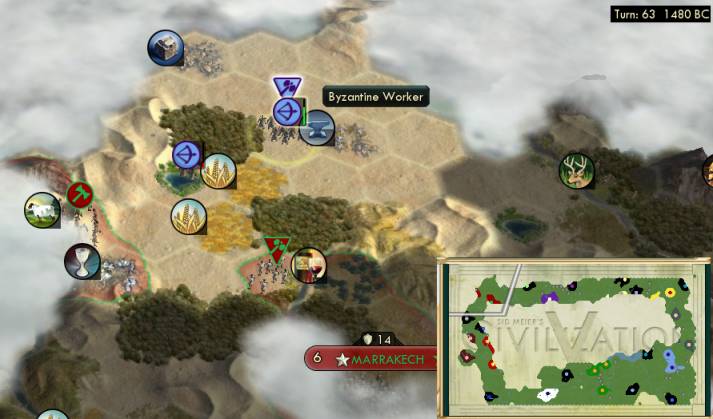
One of the many reasons I like Inland Sea is the always predictable macroscopic layout. Scouting is easy, just go around the ring in each direction. You never get stuck on a peninsula or mountain range or behind expanding borders or some such, the scouts can always keep driving onwards for more ruins and contacts and city-states. It often happens that the two scouts will meet each other on the far side, and did so here.
Both scouts had been ruins-upgraded to archers. That's actually enough power together to knock off barbarian camps. They did so here -- although strangely, the game didn't give me any option to return that worker, I was stuck with it. I later realized this happens if the recaptured worker belongs to a civ or city-state you haven't contacted yet. Against considerable odds, that worker actually did manage to safely creep all the way around the world back home, though took a good forty turns to do so.
Anyway, Team Archers stuck together for a good long while, making another circuit of the inland sea together. They cleared quite a few barb camps and accumulated several city-state friendships and alliances that way. They also liberated an Iroquois worker, which I returned and then Hiawatha friended me, a nice payoff.
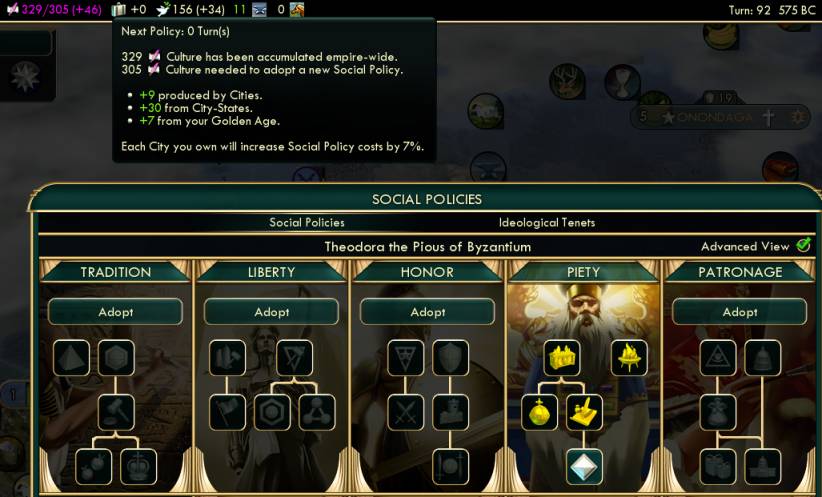
Those CS alliances were mostly cultured ones, which chained back into finishing Piety surprisingly early, on turn 92. Turns 80-90 are typical for completing Tradition or Liberty, but those trees boost themselves with their own culture production, while Piety has no such feedback. But here, the cultured city-states were totally dominating my own civ's culture.
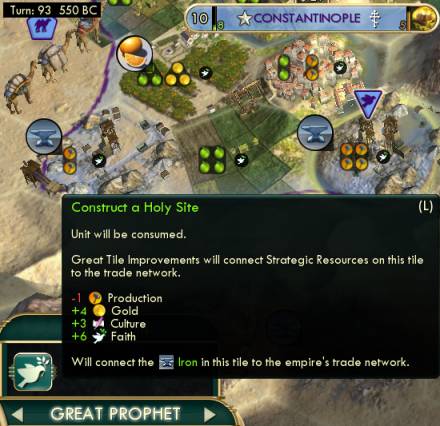
Conventional wisdom is you're supposed to enhance your religion with the Piety finisher prophet, but I actually settled him here. Finishing Piety also adds 3 each gold and culture to the Holy Site, and I rarely get to do that so wanted to see it here. (Why does it say +4 gold? Golden Age.) The iron is the right place to do it, because that's a tile you're always going to want to work anyway, and it keeps the strategic resource connected (it does NOT connect a luxury resource), and the opportunity cost of the lost mine is low until Chemistry.
I also discovered that the Piety finisher prophet does NOT count towards the Great Prophet cost counter. Unlike the Liberty finisher. I will never understand this game.

I took one missionary with faith early to get it to my own cities, then let it accumulate to the 300-point Great Prophet for enhancing. Here's the religion, although this screen was not updated in BNW to include the Reformation belief, yet another of the rough-edge oversights common to Civ 5. Anyway, there's the belief menu. Now all my faith would go into missionaries. Holy Order (-30%) and Mandate of Heaven (-20%) apparently stack multiplicatively because the missionary cost came to 110 (200 * 0.7 * 0.8 = 112, rounded down) not the additive (subtractive) value that would be 100.
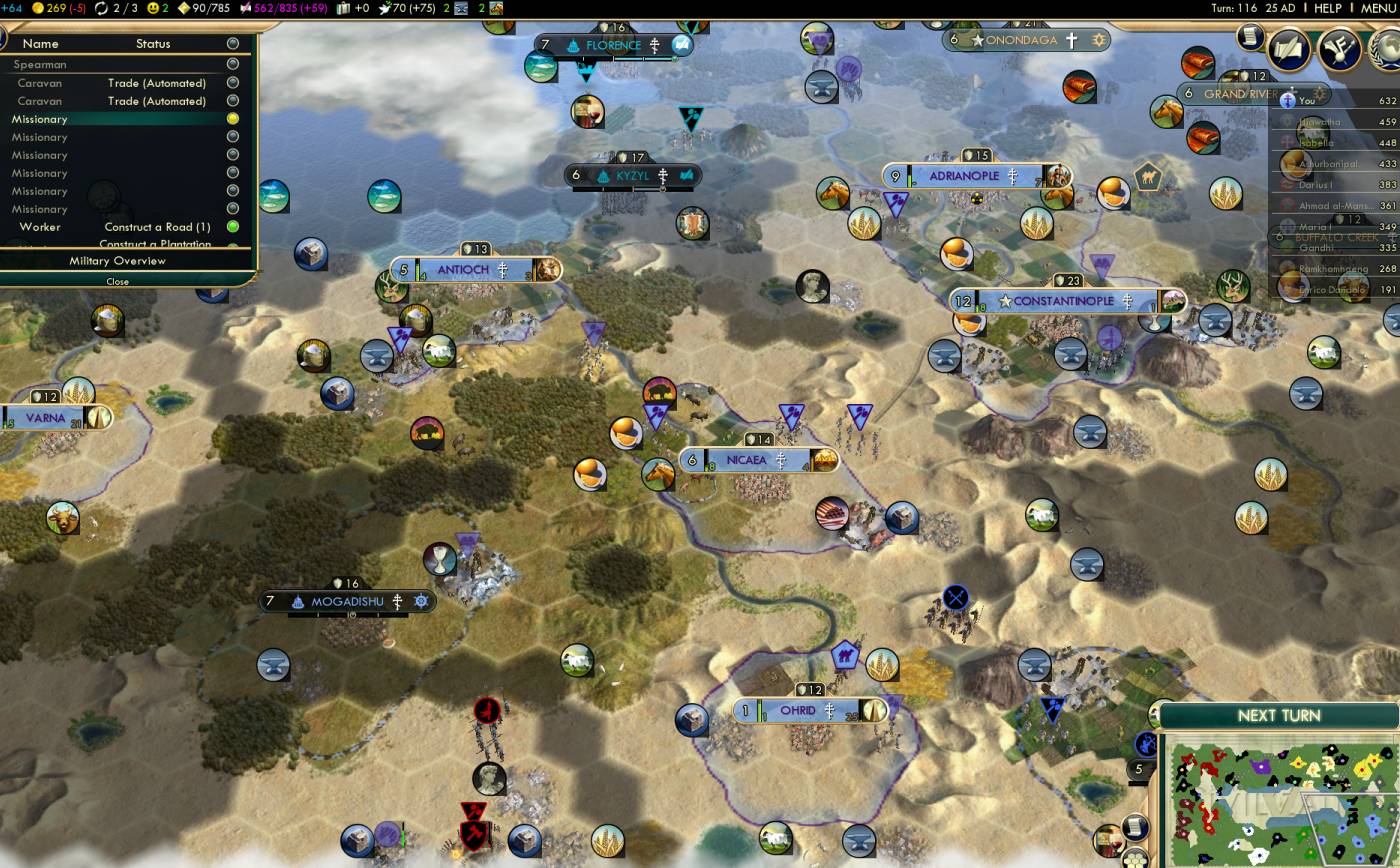
I was expanding while all the religious stuff was happening of course. I hit a nice rhythm, each time I was ready to expand with military and worker support, I'd accumulated just about enough gold from resource sales to buy that settler. I endured a couple barbarian pillages at Constantinople, which is common and actually helpful to be able to resell the resource over again. Although presently I had to start keeping the luxuries for myself rather than selling.
My neighbors were India to the west and Iroquois to the north. This turned out a bit awkward, since both had friended me, but established their own religions, so I wouldn't want to sweep them with my own. But the next neighbor on each side, Portugal (white) to the west and Siam (yellow) to the north, did not get their own religions. Actually that seemed to work pretty well in the long run - I spread my religion to the next-neighbors and they projected pressure back onto my immediate neighbors.
75 faith per turn, half of it from Desert Folklore and half from Pilgrimage. I was already pumping out almost a missionary per turn. That shot shows six missionaries active, and that's Borobudur one turn from done in the capital for three more.

And I started to see the Evangelism belief in action. I still can't pin down how the math works, and the CFC forums seem silent on the subject. But it's certainly not intuitive. Look at these two cities. One would see a gain of 4 followers up to 7, and the other would get only 1 follower! This was really weird and hard to understand.
Two principles seemed at least somewhat consistent. One was that the effectiveness of the spreads depended on the existing pressure in the city, not just the follower count. With low pressure of +6 or +12, one missionary would often wipe out almost all heathen followers and achieve a majority right away, but with higher pressure such as the +30 inherent to holy cities, he wouldn't make much progress. My other guess is that Evangelism's erosion works as a percentage of the city's population rather than as a percentage of the pressure; it seemed that missionaries would consistently clear out 2 or 3 existing followers as 25% of the city's pop.

The Evangelism erosion also seems to work separately for each religion present in the city. Here, the pattern follows by the following logic: if we erode 2 followers from each of those religions, that leaves 3 remaining of Catholicism, leaving 7 unaligned followers that will pick up my Eastern Orthodoxy as the tooltip says. So you get more mileage from Evangelism cleaning out several competing religions at once.

But some cases just defied any logic I could think of. This city would only get 4 followers even after the erosion. I have no idea why.
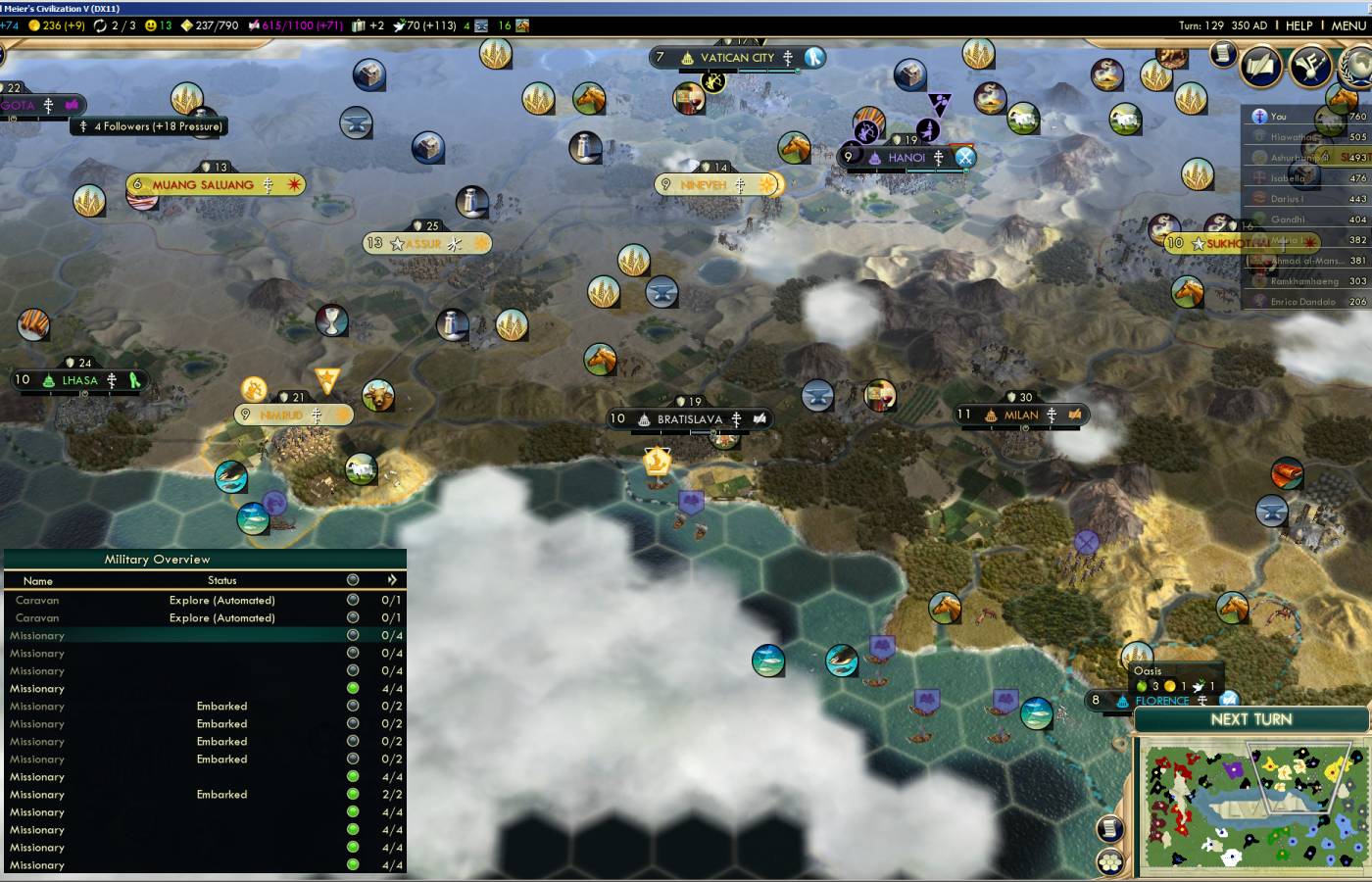
But all told, Evangelism does indeed work very well, and there were many more good cases of spreading than bad. Here's the northeast quadrant converted to my religion at a fairly early date. That racked up Pilgrimage quickly; at +113 faith I'm now at more than one missionary per turn. That's 15 missionaries plying their profession, and you can see several sailing by in that picture. Okay, this might have been kind of overboard. I should have taken a faith-building follower belief to spend some of it on. And Borobudur was definitely silly overkill, we didn't need those three missionaries and could have spent the hammers better.
I now started letting most of the faith go to prophets instead, despite the original plan not to. I actually ended up getting and settling four prophets in all, from the 300, 500, 800, and 1200 faith levels. Yes, that's 2800 faith spent on settled prophets for a total of 24 faith yield, more than 100 turns to payback. But the culture and gold do have value, and really the important part is to get the next Prophet cost counter up to 1700 in order to get 1699 headroom of pre-saved faith before the industrial age. And I alertly put two of the holy sites at my newer cities rather than the capital, to put the holy site culture into border expansion. I also settled the first Great Scientist, who came precisely 100 turns after the Great Library.
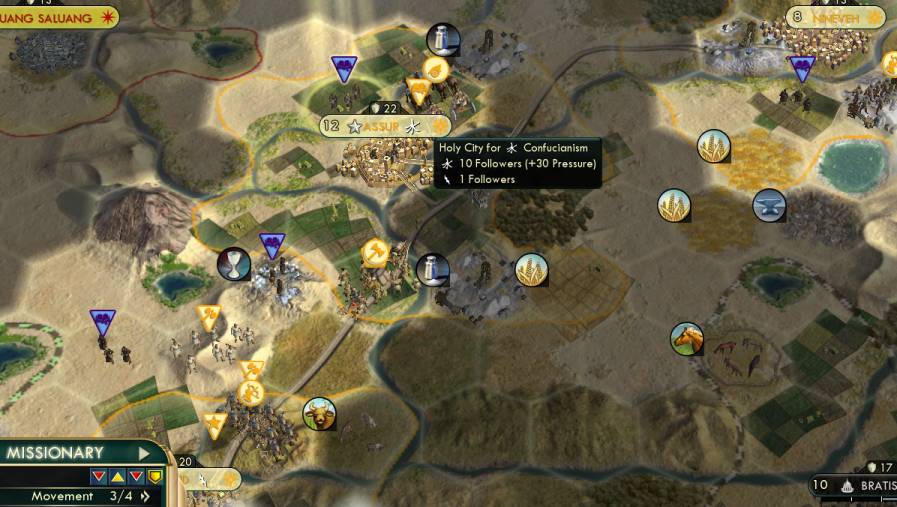
The best targets for missionaries are civs that didn't found their own religions, of course. But I had so many extra missionaries that I had to put some of them towards stiffer targets. Of course, civs with their own faith don't like it when you spread yours. I decided to try this plan: set up to blitz all of a civ's cities in one turn, before they could react with "stop spreading", then truthfully reply with "okay we'll stop", and hopefully all that would count as only one diplomatic hit. This seemed to work in fact, Ashurbanipal of Assyria here got a bit annoyed but never denounced or really became hostile.
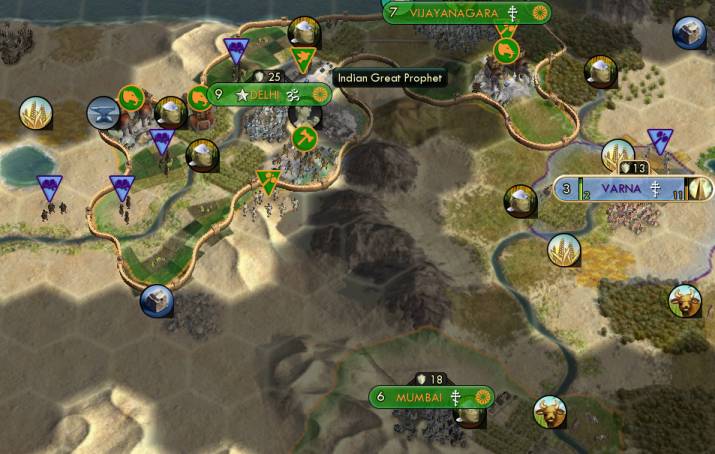
I did the same thing to India, but that one came out terribly thanks to poor timing, he popped a Great Prophet right after my deed to go undo it. India later did denounce me, although I think it was more from other factors (close settling and city-state competition) than the religion spread.

An alternative tactic was this: spread to religious civs without directly converting the cities. If carefully done, I could bring a city just to the verge of conversion to my religion, then let pressure actually push it over the top. AI civs do not get mad at you for this! I even went as far as deliberately letting a few missionaries weaken to attrition so I could spread just under the conversion threshold. In this way, I stealthily flipped most of the Iroquois cities to my side without ever actually converting one, and Hiawatha remained oblivious and friendly the whole time. This plan requires a lot of passive pressure, but I had that thanks to the Iroquois being tightly boxed in between my own cities and religious fellows Siam and several city-states.

Finally, in the long run, that total of missionaries came to just about the right amount. I covered the northwest quadrant as you see here, including Morocco in the far corner. But what consumed my excess stock of missionaries was some really intense religious warring over these city-states. Kiev in particular got hit literally almost every turn by a missionary or prophet from me or Spain or Persia. My Evangelism-powered missionaries could just about go blow-for-blow with a prophet, and of course I could zerg-rush out many more of them than my rivals. Nobody ever got the upper hand at Kiev itself, but what this exercise did was keep all the skirmishing there, while the other city-states and Morocco itself stayed firmly in my fold behind that buffer zone.
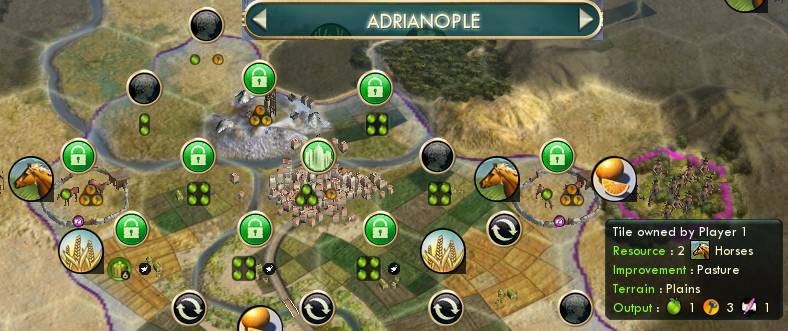
How is that horse tile producing culture? Hey, Religious Tolerance is actually doing something! That's from the pantheon of the neighboring Iroquois. Highly amusingly, that culture would even convert back into tourism later with the hotel.
The traditional 1000 AD overview.

We can see both of the founder beliefs paying off handsomely. 60 faith from Pilgrimage, so I can rest knowing I delivered on that. And 18 happy from Ceremonial Burial. That seems to have been nerfed just about right in BNW (1 happy / 2 cities instead of 1/1) onto a comparable power level with the other founder beliefs.
Also see that number of 7 Local City Happiness. That's low. What this means is I've gone this far without colosseums, that's just the Palace and a few circuses. Colosseums always seem to me like the telltale as to whether your expansion was efficient on happiness. They're not terrible build options, but it's noticeably more efficient to be able to skip them in favor of better things.
However, I started bumping into the happy cap fairly hard around now. My missionaries had reached the peak of converting all available cities (leaving civs with their own religions), and I'd even slowly start leaking happiness from there as AI prophets would overtake my missionaries as I saved faith for the industrial age. I also had all the city-states I could reasonably get, and now did have to resort to colosseums.
Moving away from religion for the moment, let's cover the rest of the game plan.

Somehow I racked up a ridiculous amount of culture from city-states. There were NINE on the map, and something like seven came into inadvertent alliance with me. After Piety, I filled up Aesthetics quickly, finishing it on turn 165. Three more policies followed before I reached ideologies, and the natural choices were Rationalism, Secularism, and then the Exploration opener just to enable the Louvre.
I also had research running faster than I had the production to make use of the technologies. Thanks to the early National College, I reached Education a dozen turns before I was ready to build universities, still busy on granaries and aqueducts and libraries.
So for the midgame tech plan, I went with a blast from the past. This map saw my cities growing population and technology considerably ahead of production. When that happens, what you need to do is find technological benefits that kick in right away without needing more production or money invested. On the Civ 5 tech tree, this is Chemistry and Fertilizer. Back in Civ 5 vanilla, it seemed that every game beelined through those first. More lately the game plans have been focused towards Archaeology for tourism or Scientific Method for science. But here, Chemistry and Fertilizer worked, which were a good idea also because that was the fastest route to the industrial age to enable buying artistic Great People with my vast stores of faith. I reached Fertilizer on turn 170.
But I still didn't have enough production. My capital was rather weak in the production department, and I missed a ton of wonders. Petra, Oracle, Chichen Itza, Hagia Sophia (by two turns!). I was missing Aristocracy bigtime, yeah Tradition is still the king of the policy trees. Later I missed Leaning Tower, Taj Mahal, Sistine Chapel, and even the Globe Theater by four turns! That happened because I went to Fertilizer and got to the wonder techs a bit too late. I also felt bad on putting off the Grand Temple, for once I could actually use that pressure with a bunch of rival cities in range from my capital, but just couldn't fit it in the build order. Eventually I did find my footing and start capturing the later renaissance wonders in Uffizi and the Louvre.

Okay, I certainly wasn't the only one with trouble getting production out of flood plains!
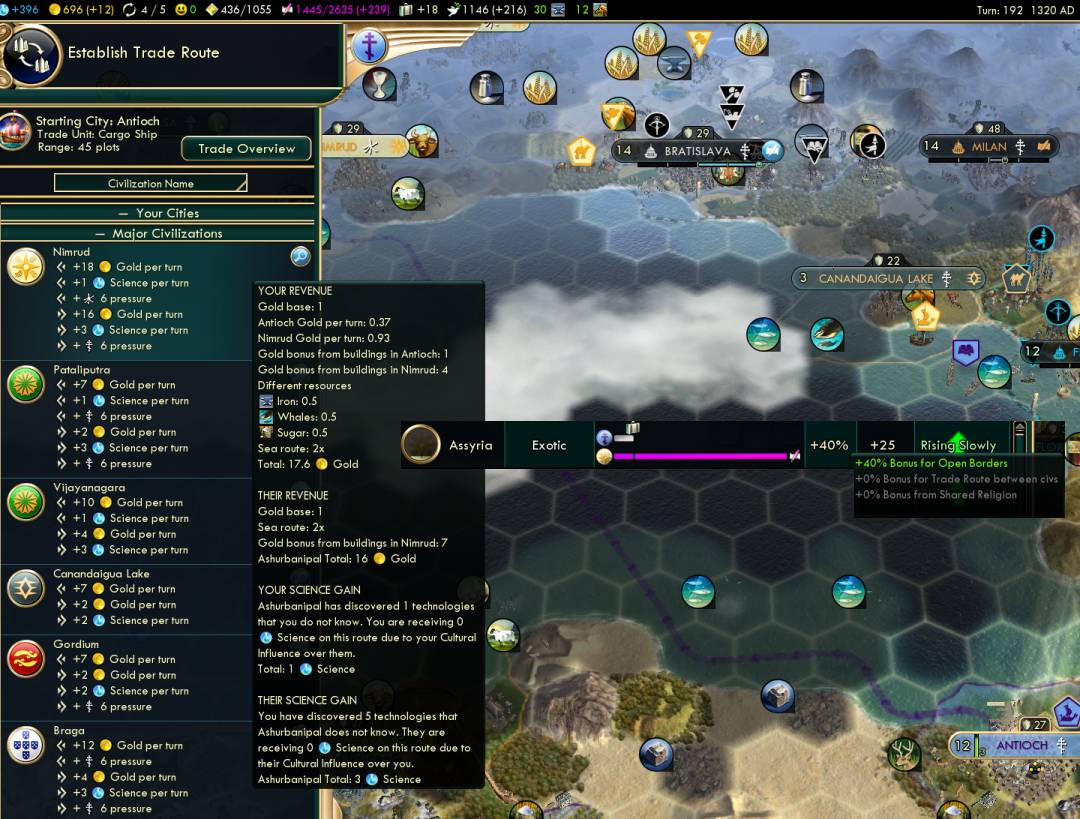
I alertly built a harbor and a cargo ship for this trade route. Assyria was the best culture producer and also wouldn't share my religion for the tourism modifier. I needed the trade route just for that. But hey, it was decently profitable in its own right as well.
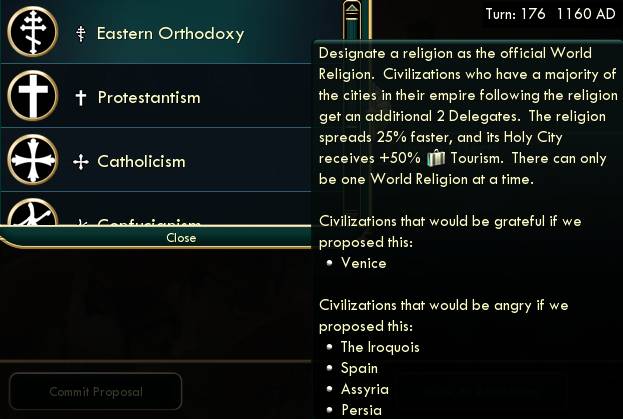
So, back to religion. After Fertilizer, it was on to Printing Press for the World Congress and to propose World Religion, the crux of the latter half of my game plan. Two Research Agreements matured and got me to the tech quickly. Strangely, three of my religious buddies weren't supporting the motion, only Venice did. But Fertilizer for the industrial age had gotten me two spies/diplomats, which I now rotated through all the civs to accumulate votes.
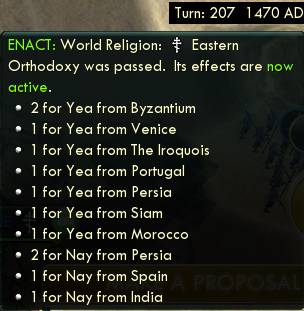
30 turns later, it passed, although this wasn't without an oddity. Look at the split vote from Persia, 1 yea and 2 nay. How is that possible? Darius had gotten the Forbidden Palace and its +2 delegates during the meantime between proposing and voting. I had paid him 12 gpt for his support, assuming that fairly high price was getting me all three of his delegates. But that wasn't true, apparently the only vote commitment is the delegates the civ STARTS with, not more that were acquired. So I got ripped off a bit here.
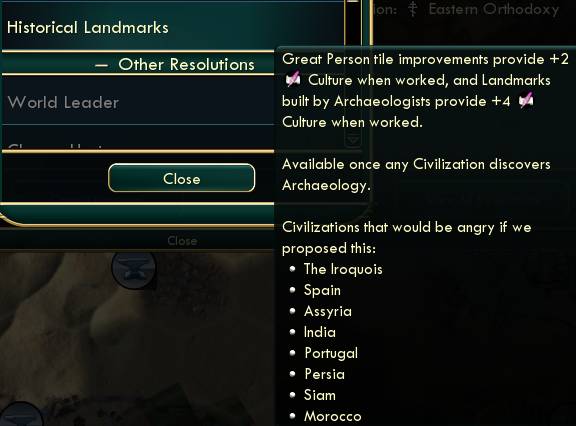
What to propose next? Well, obviously I wanted Historical Landmarks for my four settled holy sites and upcoming landmarks. But EVERYBODY hated it. That would be quite an uphill battle to get passed, so I took a pass on that and went with Arts Funding instead that had much more support.
Back to tech. I learned from past experience the right approach to technology: slingshot up to Refrigeration as soon as you can. I did this by way of bulbing my two scientists for Biology and Electricity; the bulb value wasn't going to increase without public schools that wouldn't ever become a build priority. Oxford University claimed Refrigeration itself.
So all these threads wove together skillfully. All at the same time, I enacted World Religion, completed Uffizi for a sizable theming bonus, and slinged the tech to buy the Hotel. All these multiplied together to take me up over 60 tourism, with the listed victory dates already within 100 turns.
The slingshot to Refrigeration also reached Ideologies at a timely moment, when there were no other regular policies that warranted investment. Order for its happiness and Five-Year Plan was really tempting, but I had to go with Freedom for the usual specialist enhancers and New Deal. For once I actually had all the pieces for New Deal, several settled holy sites and also several ruins-to-be-landmarks within city range.
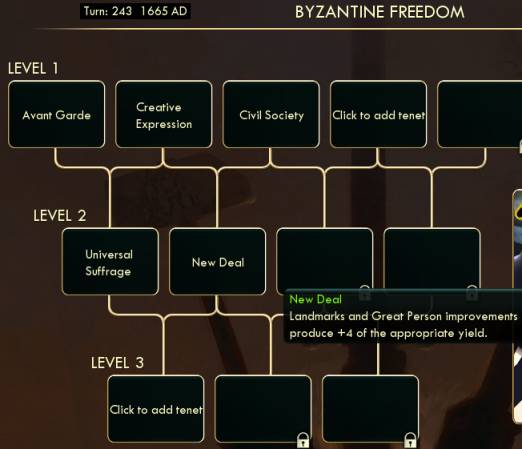
Freedom also contains Media Culture, +34% tourism with a Broadcast Tower... but actually I would win the game before getting to that.
To buy the hotel, I sold vast piles of all the newly discovered industrial era resources. (The game might like to space out coal, oil, and aluminum a bit on the tech tree; they all come in rapid succession with adjacent techs.) Oil in particular was plentiful in my desert.

Here's a heinously stupid detail. This city was about to acquire the archaeological ruin tile by culture. But when the dig was completed and the tile switched to a landmark, suddenly and immensely stupidly, the tile picker switched to an empty desert square instead. What the goddamn hell, guys. Its price even jumped up from the base to the next cost tier. Of course I could and would pay it, but man the Civ 5 haters might know what they're talking about. This is the sort of broken junk you get by cramming in too many subsystems and not properly testing the interactions. There's no way converting a ruin to a functioning landmark should lower its priority.
Anyway, I was rapidly approaching the endgame. I built the Louvre, and continued research up to Radio and the Eiffel Tower, although it came late enough that it probably didn't save any turns on the victory. I bought three each of Great Writers and Artists with faith, up through the 2500 level, filling in a bunch of great work slots. The regular GP production from the artistic guilds had been happening all along as well.
A refinement that I got right: save your faith purchases of Great Musicians to the end, so they can deliver the strongest concert bombs. Don't buy one to make a great work, no amount of multipliers will make a 2 tpt great work come out to 1500 tourism by the end of the game.
A refinement that I didn't: optimizing city build picks. It needs to depend on whether a city has a landmark within range. Cities that do need to build their Hotel as soon as they can, and then also the Museum, to put its artwork slots in the same place as the hotel tourism multiplier. Cities without a landmark should be the ones making Archaeologists. I didn't get this right and had the wrong cities doing the wrong things, having to delay hotels to complete an archaeologist or vice versa.
A refinement that was out of my hands: getting the right pieces to assemble the Louvre theming bonus. This requires two artifacts and two artworks from four different civilizations and four different eras. Artifacts were the limiting factor, limited to my own runs since nobody else was digging them. I kept hitting Byzantine ancient artifact after Byzantine ancient artifact which wouldn't work, then finally a foreign medieval artifact but that didn't work either since the only foreign artworks available for swapping were also medieval.
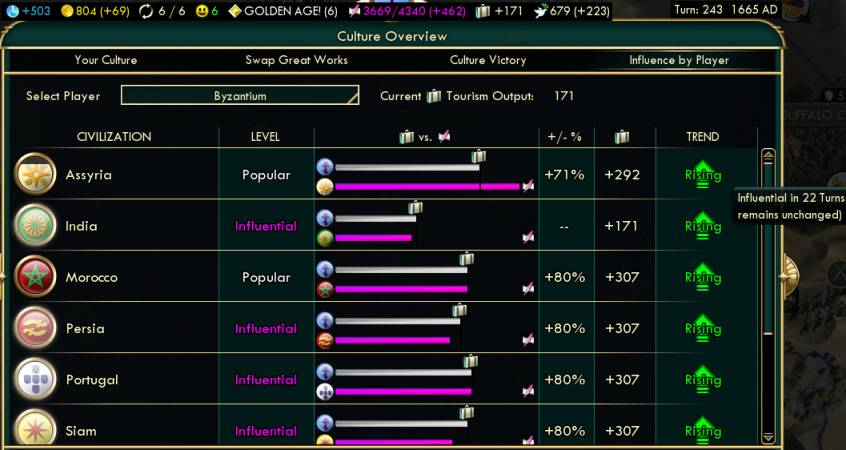
The culture field worked out in the most convenient manner: every civ went influential at just about the same time (within 5 turns), except for one stubborn holdout. That was Assyria, so my Great Musicians targeted there.
Note that Great Musicians actually accelerate the win by more than the 10 turns of their face value. Because your progress per turn is really your tourism minus the target's culture, but a concert bomb is all positive with no competing subtractive element. It's equivalent to 10 turns of tourism production as if the target had zero culture defense. The same deal happens for other tourism modifiers, like World Religion really accelerates by more than 50% since it multiplies the full offense rather than offense-minus-defense.

Turn 239, I finally dug up the artifact I needed to complete the Louvre theming bonus. This brought my tourism production to 153. My saved faith also crested 5000 on this same turn to buy the three Great Musicians all together (1000, 1500, 2500). I dispatched them all to Assyria as mentioned. Amusingly, they can perform the concert right from the sea.

Culture Victory on turn 246 1680 AD. Still improving, 7 turns faster than the Egypt game. Even though this game wasn't really played as well, diverting out on silly religious lines; the difference came from World Religion and optimizing the endgame correctly.

Tourism victories do give a satisfying ending, looking back over this screen of accomplishment. However, this screen looks less accomplished than the same view in the Egypt game. Fewer wonders, fewer great works, and this one looks disorganized in how few cities even managed to complete the culture buildings. But that's actually good in game terms! Means I won more efficiently rather than through more force. I learned this back when playing speed games in Alpha Centauri -- chaotic discrepancies between cities are actually good, it means they are running according to their own optima rather than following a rigid prescribed path.
Of course the big piece that made me finish sooner was the World Religion tourism bonus. I'll have to figure out how to work that in to future attempts, with a more efficient and less overkilly approach to religion.